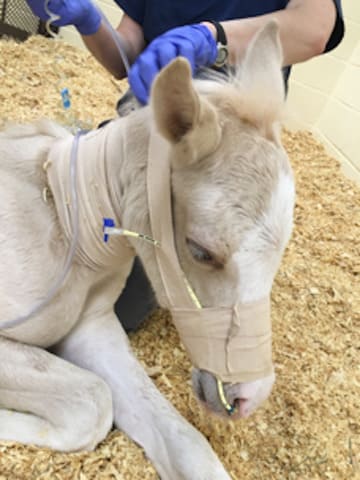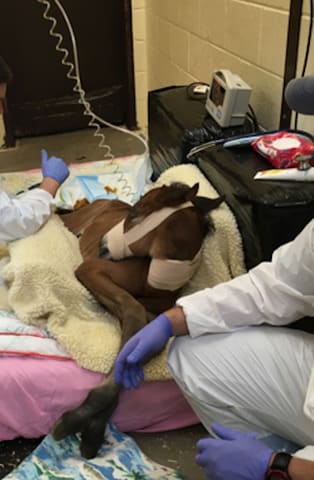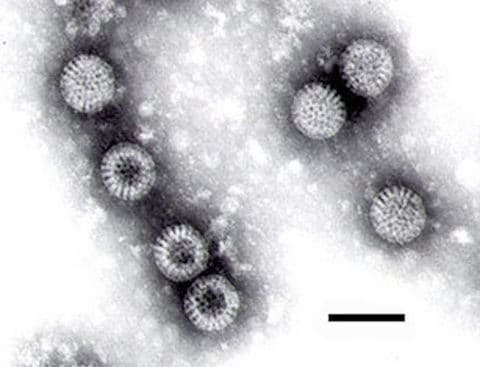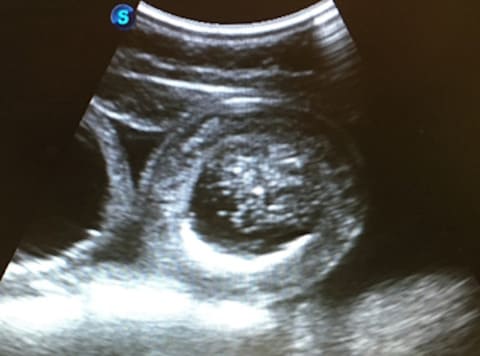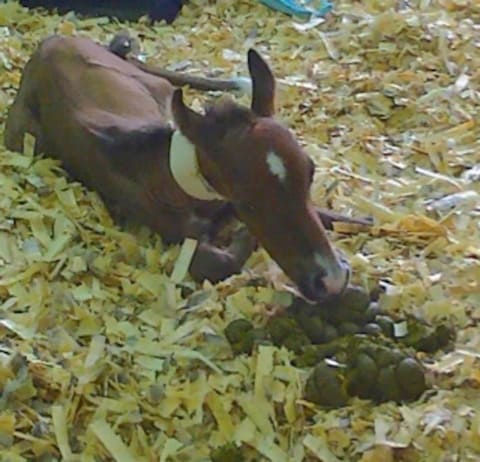For my own personal use only:
- Clostridiosis
- Classic case: Less than 5-d-old (and definitely
less than 10 d) foal

- Acute
- Hemorrhagic diarrhea
- Colic
- Severe obtundation
- Hypovolemic/septic shock
- Often rapidly fatal
- Dx:
- Etiology:
- C. perfringens type C (less commonly, type A)
- C. difficile can also be found in intestine/feces of healthy foals and adults
- Fecal toxin analysis
- PCR for C. perfringens
- ELISA for C. perfringens and C. difficile
- Fecal culture +/- blood culture
- Abdominal ultrasound: see necrotizing enterocolitis - thickened bowel wall with gas in the wall
- Necropsy: intraluminal hemorrhage and mucosal necrosis of small intestine (+/- colon)
- Etiology:
- Tx:
- Metronidazole PO or per rectum
- Supportive care (applies to all these foal
diarrheas):
- Broad-spectrum antimicrobials to decrease risk of bacterial translocation and sepsis
- IV fluids with electrolyte replacement
- Correct failure of passive transfer, if present
- NSAIDs
- Anti-endotoxemics: polymyxin B, hyperimmune plasma
- Intestinal adsorbents: kaolin, pectin, bismuth subsalicylate, di-tri-octahedral (DTO) smectite (Biosponge®)
- Nutrition: enteral feeding or parenteral nutrition
- +/- Lactase administration PO
- Prevention:
- Improve farm hygiene
- Vaccine?
- Pearls:
- Prognosis is guarded
- Can occur in outbreaks or sporadically
- Classic case: Less than 5-d-old (and definitely
less than 10 d) foal
- Salmonellosis
- Classic case: Usually foals less than 1 mo old

- Diarrhea
- Lethargy, poor nursing
- Sepsis
- Progresses to hypovolemic shock - cool limbs, thready pulses, recumbent
- Dx:
- Etiology: Most often Salmonella enterica
- CBC shows severe neutropenia
- Fecal PCR or culture
- Tx:
- See supportive care guidelines under clostridiosis
- Pearls:
- ZOONOTIC
- Salmonella can be present in healthy horses' feces
- Stress can increase fecal shedding
- Classic case: Usually foals less than 1 mo old
- Rotovirus/coronavirus
- Classic case: Foals less than 2 mos old

- Depression, anorexia
- Profuse, watery, malodorous diarrhea
- More severe in younger foals
- Self-limiting, usually lasts 4-7 d
- Dx:
- Fecal immunoassay kit
- Fecal electron microscopy
- Tx: See supportive care guidelines under clostridiosis
- Pearls:
- Rotavirus more common than coronavirus
- Rotavirus destroys enterocytes at tips of small intestinal villi, leading to malabsorption
- Often secondary lactase deficiency
- Use rotavirus vaccine in pregnant mares
- Highly contagious
- Classic case: Foals less than 2 mos old
- Lawsonia intracellularis (a.k.a.
"proliferative enteropathy")
- Classic case: 4- to 6-mo-old foal

- Poor doer, failure to thrive, weight loss
- Diarrhea
- Pot-belly
- Colic
- Ventral abdominal subcutaneous edema
- Dx:
- Usually do both:
- Fecal PCR
- Serology - IFAT (can be hard to differentiate exposure from disease with 1-time sample)
- Abdominal ultrasound: thickened small intestine
- Bloodwork: marked hypoproteinemia
- Necropsy: silver stain shows characteristic intracellular bacteria in small intestinal tissue
- Usually do both:
- Tx:
- Antimicrobials: tetracyclines, erythromycin, or chloramphenicol
- Plasma transfusion if severely hypoproteinemic
- Pearls:
- L. intracellularis is an intracellular bacteria
- Does not grow in culture without permissive cell lines
- Lipophilic or amphoteric antimicrobials required
- Excellent prognosis with recovery
- Takes 4-8 wks for full recovery
- Causes a protein-losing enteropathy
- L. intracellularis is an intracellular bacteria
- Classic case: 4- to 6-mo-old foal
- Foal heat
- Classic case: 4-10-d-old foal

- Mild diarrhea, NOT malodorous
- No other clinical signs
- Dx: Usually none
- Rule out other causes if necessary
- Tx: Usually none
- Apply protectant (e.g. zinc oxide or vasoline) around perineum, on hind limbs
- Pearls:
- Not actually related to mare's heat cycle because also seen in orphan foals
- Most likely due to changes in foal's GI flora - as foals start eating grain and hay in addition to milk, and as they perform coprophagy to inoculate their GI tracts
- Often concerning to owners
- Classic case: 4-10-d-old foal
Images courtesy of Véronique Mestre Gibaud (foal running with mare), F.P. Williams, U.S. EPA (rotavirus), Jim Champion (foal portait in table), Nora Grenager, VMD, DACVIM (feeding tube, NICU foal, L. intracellularis ultrasound, coprophagy, and foal/mare eating).
Top Topic Category
Equine
